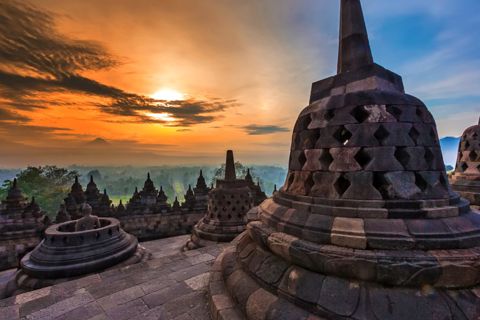
Borobudur Temple is located in Magelang Regency, Central Java with a Buddhist pattern. It is estimated that Borobudur Temple was founded during the reign of the Syailendra Dynasty between 750-842 AD. The purpose of building Borobudur Temple was to glorify the teachings of Mahayana Buddhism. Not yet found with certainty who the founder of the Borobudur Temple. According to historian J.G. de Casparis mentioned that the founder of Borobudur Temple was King Samaratungga. Meanwhile, King Samaratungga led Ancient Mataram in 782 – 812 AD during the reign of the Syailendra dynasty.
Other sources say that Borobudur Temple was founded by King Wisnu starting in 770 AD and finished in 842. In 928 and 1006 this temple was abandoned by the Medang Kingdom during the reign of Empu Sindok who expanded to East Java. This displacement was due to a volcanic eruption around the area of Ancient Mataram.
Borobudur Temple had been abandoned and then rediscovered by Sir Thomas Stamford Raffles in 1814 when visiting Semarang. This finding is based on reports of findings of carved stones on a hill in the village of Bumisegoro, Magelang Residency. The hill is believed to be the remains of a temple building or called budur. Raffles then sent his envoy named Cornelius to conduct research in 1814 and started cleaning in 1817, 1825 and 1835.
Borobudur Temple has been restored several times. This restoration is intended to restore the function and physical form of the Borobudur Temple. The restoration was first carried out by Th. Van Erp in 1907 to 1911. This restoration was carried out by the Indonesian government in cooperation with UNESCO.
Borobudur Temple structure Borobudur Temple has 3 major structures viz.
Kamadhatu (Foot of the Temple)
The lowest part of the Borobudur Temple is Kamadhatu as the foot of the temple which symbolizes human life in a world full of ugliness, lust and sin. At the bottom there are many piles of stones which are thought to be the supports for the body of the temple. There are 160 reliefs that explain the Karmawibhangga Sutra, namely the law of cause and effect.
Rupadhatu (Temple Body)
The middle part is called Rupadhatu which describes human life that is free from lust but still bound by worldly things. The Rudhatu structure consists of four square terraces. On the walls there are relief decorations.
Arupadhatu (Above the Temple)
The very top of the Borobudur Temple is named Rupadhatu which describes human life that has been freed from the highest worldly and spiritual affairs. This level is a symbol of the Buddha who has attained perfection.
In total there are 504 Buddha statues with healthy attitudes and six different hand positions.
